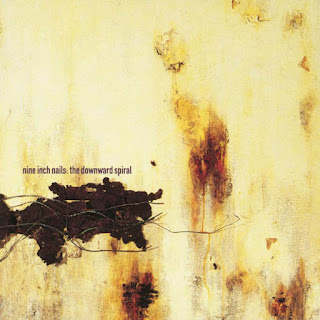Trent Reznor's Nine Inch Nails,
which is really just him and whoever he is working with at any given time, was
well-known in the underground rock and industrial music world long before the
spring of '94, but the release of the project's second full-length LP 25 years ago introduced a massive number of generations X and Y to passionate but heavy rock
music that thoughtfully challenged religious institutions, society, and dealing
with various forms of mental and emotional anguish. Sure, the music is dark,
loud, and mostly comes across sounding depressing, but what is the point and
purpose of using those tones and moods in any artistic creation? Attempting to
represent or reflect the saddest, rawest, and most personal of all hurt
feelings and injustices in the world would probably result in some pretty dark
and depressing stories, paintings, or poems as well.
What sets Nine Inch Nails, and this LP, specifically,
apart from something more along the lines of death metal, black metal, or even
heavier goth-industrial acts like Skinny Puppy or Reznor's friends,
Ministry, is the desire to present this type of gothic-industrial rock music as
though it is prog-rock instead, which ends up coming across as something
different than both of those sub-genres. What if Bauhaus had tried to make a
Genesis album? Guest appearances from King Crimson's Adrian Belew,
super-producer, Flood, and even a bit of programming assistance from Motley
Crue's Tommy Lee show both the range of Reznor's influences and the large
musical reach to attract fans of various styles of rock music, and everyone
from Marilyn Manson to the emo to screamo bands owes quite a bit to what Reznor
accomplished on this album.
"Mr. Self-Destruct" sets the tone for the
album, which is a loose concept record about the descent of a character into
suicidal madness triggered by a variety of emotional burdens and heavy
thoughts, which itself is a nod to at least two of Pink Floyd's classic LPs.
The aggressive assault of the song cuts into a collage of guitar flurry which
then dynamically changes to one of the album's quietest and creepiest songs,
"Piggy." Along with the lead single, the seriously-rocking mosh pit
anthem, "March of the Pigs," it is worth noting that much of this
album was recorded in Trent's residence of that era, which happened to be the
former home of Charles Manson Family murder victim, Sharon Tate. Reznor has
since discussed how he chose to move out of the house shortly after a personal
conversation with Tate's sister, but this was after the recording had finished,
which lends another layer of genuine fear-factor to the album. This was all in
a time where rumor traveled by word-of-mouth and verification was difficult
prior to wide-scale internet access, though that was just around the corner.
"Heresy" is at least up-front about its
lyrical subject matter, mostly paraphrasing some of Nietzsche's quotes and
thoughts that are certain to rile up suburban parents a lot more than
philosophy students. The biggest hit from the album, and arguably of the
entire Nine Inch Nails catalog, is "Closer," a pulsing, electronic,
sexual confession that is bent and twisted by guitar loops and noise samples
that cross-fade from one speaker to the other and then out of the mix completely
throughout the song. This track was undoubtedly popularized also by its savage,
nightmare-inducing music video, a collaboration between Reznor and director
Mark Pellington, which was a gnarly view, even in its edited-for-broadcast MTV
version. (If you've not seen the director's cut, take a moment and hop over to youtube.
I'll wait for you.)
Crazy, right? For this sort of music to have any sort
of pop success in the mid-‘90s, or any era, is hard to believe, and yet, it led
to the even greater pop success of Reznor’s protégé, Marilyn Manson, who would
take the concept of shock rock to amazing new extremes only two years after The Downward Spiral, among other copy-cat
acts and one hit wonders that dabbled in industrial and electronic elements in
the mid and late ‘90s.
The album's second half focuses more on the rising
action and climax of the story line through the hypnotic "The
Becoming" and progressing with "The Eraser,"
"Reptile," and concludes with another of Reznor's most recognizable
songs, the mournful ballad, "Hurt," later introduced to entirely
different audiences by Johnny Cash's unforgettable 2003 cover version. After a
successful world-tour that lasted nearly two years and included an infamous,
mud-caked appearance at the Woodstock '94 festival, Nine Inch Nails had
essentially become a house-hold name compared to the project's previous years
when they were only known in indie or alternative music circles. Like any
culturally-influential artist or figure, Reznor's style has been imitated and
parodied many times over since The Downward Spiral's release and success, but it all
really started, at least on a grand scale, with this album. While there have
been many other great NIN songs and albums in the succeeding years, including
their most recent releases, (the NIN EP trilogy), most would agree this collection
of songs is their best work.
******************
OTHER ALBUMS Celebrating 25 Years:
Failure-Magnified
Green Jelly-333
Kyuss-Welcome to Sky Valley
L7-Hungry for Stink
Pantera-Far Beyond Driven

No comments:
Post a Comment